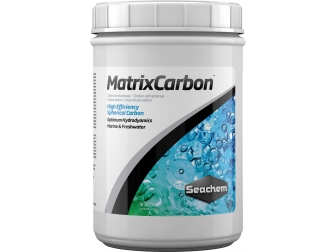- Out-of-Stock


 0
0
- High-efficiency spherical carbon
- Very little impact on pH due to low ash content
- Lowest leachable phosphate level on the market
- High removal capacity; large surface area


 Out-of-Stock
Arrivages fréquents
Out-of-Stock
Arrivages fréquents
- High-efficiency spherical carbon
- Very little impact on pH due to low ash content
- Lowest leachable phosphate level on the market
- High removal capacity; large surface area
MatrixCarbon™ is a truly unique activated carbon. It is formed into a spherical bead for optimal hydrodynamics and does not compact. It allows for maximum water flow and contact with its high-density macroporous binding sites. MatrixCarbon™ has a very low ash content, as indicated by its minimal impact on pH. Even when added to distilled water, it does not raise the pH above 7.0. While all carbons contain phosphate, despite false claims to the contrary, MatrixCarbon™ has the lowest detectable leachable phosphate content of all major brands of carbon tested. MatrixCarbon™ outperforms other high-quality carbons by at least twice in terms of total removal capacity of aquarium organics, adsorption rate, and duration of use.
While carbon is generally considered a chemical filter, this is not precisely true. It is actually a mechanical filter as well, but it is only capable of mechanically filtering objects of molecular size. It works through extremely small cracks and crevices, called macropores and micropores. Microporous carbons primarily remove smaller metals and ions (such as trace elements) and are better suited for air filtration, while macroporous carbons primarily remove larger organic molecules (such as nitrogenous waste) and are better suited for water filtration.
The ingredients from which a carbon is made determine whether it will be macro- or microporous. Coconut-based and other organic-based carbons form microporous carbons, while bituminous coal-based carbons form macroporous carbons. MatrixCarbon™ is a macroporous bituminous coal-based carbon. It is the only spherical carbon on the market, allowing for maximum water flow. It is sized to allow complete penetration by water but not small enough to escape filter bags. All carbons contain phosphate. However, this phosphate does NOT come from washing the carbon with phosphoric acid. Most carbons are washed with sulfuric acid. The phosphate is contained in the ash of the carbon source. The primary goal of acid washing is to remove the ash. Due to the hydrodynamic properties of MatrixCarbon™, more ash is washed from our carbon than any other. Consequently, it has the lowest leachable phosphate on the market.
Sizes: 100 ml, 250 ml, 500 ml, 1 L, 2 L, 4 L
250 ml will easily treat 400 L (100 US gallons) for several months.
Use in a filter bag. Rinse before use.
For best results, MatrixCarbon™ should be placed to maximize water flow through it.
It can be used in a canister filter, chemical filtration module, box filter, or any high-flow area of a trickle filter.
MatrixCarbon™ is the only spherical carbon on the market. It will not compact and create dead zones due to restricted water flow and, therefore, will exhaust all available absorption sites before depletion. The actual time depends on the initial water conditions. In very dirty water, it may last as little as a few hours; in very clean water, it may last several months. Generally, 3 to 6 months is typical.
A spherical pellet has ideal hydrodynamic properties and allows for maximum water flow and contact without the compaction and channeling characteristics of granular activated carbon. Water channeling is also a characteristic of pelletized carbon in the form of cylindrical pellets. These cylindrical pellets were originally designed for air filtration and have poor water hydrodynamics. MatrixCarbon™ also has minimal impact on trace elements, an added bonus for the planted aquarium.
Compaction
Compaction occurs over time when the flat edges of granular carbon lie against each other. Over time, the carbon becomes so tight that water flow is hindered. When this happens, water-carbon contact is minimized.
Channeling
When the problem with granular carbon is that it is too tight, the problem with cylindrical pellets is that they are not tight enough. As a result, channeling occurs. Water moves easily through the channels between the carbon, minimizing contact with the absorption sites.
Optimal Hydrodynamics
MatrixCarbon™ solves both compaction and channeling. Due to its unique spherical shape, MatrixCarbon™ provides maximum water flow and contact with a high density of adsorption sites without the compaction of granular activated carbon.
Yes, since Cupramine™ is bound to an organic, you can use carbon to remove the product.
MatrixCarbon™ is an aggressive media and will have minimal impact on trace elements. For this reason, you may want to consider Purigen®. Purigen® is an aggressive organic cleaning resin that is highly selective in its removal. It only targets nitrogenous organic matter. This product also polishes the water and is regenerable, making it more cost-effective in the long run.
All carbons are made from organic materials (wood, nutshells, etc.), so they inherently contain phosphate - it's unavoidable. If a company claims their carbon contains no phosphate, it is not carbon (perhaps a carbon-like substitute such as Renew™) or the company is engaging in creative formulation regarding their carbon. MatrixCarbon™ has the lowest leachable phosphate on the market; it will add less phosphate to your water than any other available carbon.